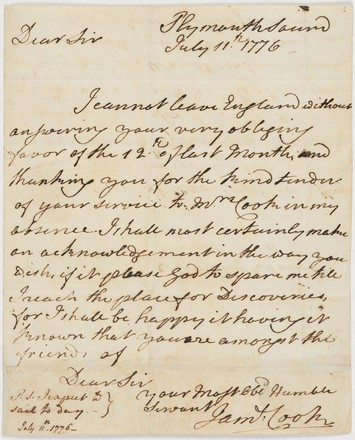Letter from James Cook to Rev Dr Richard Kaye
1776
Manuscript
Bequest of Sir William Dixson, 1952
DLMS 92
The clergyman and scientist Richard Kaye became rector of the parish of Kirkby in northwest England in 1765, and was still serving in that position in 1776 when James Cook departed on his third voyage of discovery. Considered a man of great character, intellect, faith and compassion, Kaye became a friend of James Cook and a much-appreciated support to Cook’s wife Elizabeth during Cook’s long absences.
Honouring a promise made in this letter to acknowledge Kaye’s service, Cook named the island now known as Kayak Island in the Gulf of Alaska after him. Visiting there on 12 May 1778, Cook buried a bottle with a paper and two small pieces of silver given to him by Kaye.
Long distance love
James Cook married Elizabeth Batts of Shadwell, London, in December 1762. During the first few years of their marriage they spent the winter months together, firstly at their lodgings in Shadwell and then at their own home in Mile End Road.
Soon after their marriage, Cook returned to the Newfoundland survey, and 1764 won his first command in the Grenville. The acquaintance he made at this time with the future admiral Sir Hugh Palliser and the publication of a number of his charts brought him to the attention of the Royal Society and the Admiralty, and led to his appointment as leader of an expedition to the South Seas to observe the transit of Venus, and promotion to lieutenant as commander of the Endeavour.
With this appointment, James and Elizabeth’s lives would change forever. Embarking on the first of his three epic voyages of exploration in August 1768, Cook would spend most of his time at sea, with only brief interludes at home between August 1771 and July 1772, and again between July 1775 and his departure on his ill-fated third voyage in July 1776. Together, they had six children: James, Nathaniel, Elizabeth, Joseph, George and Hugh. As well as enduring long separations, they also bore the pain of losing three of children – Elizabeth, Joseph and George – in their infancy.



 Back to list
Back to list